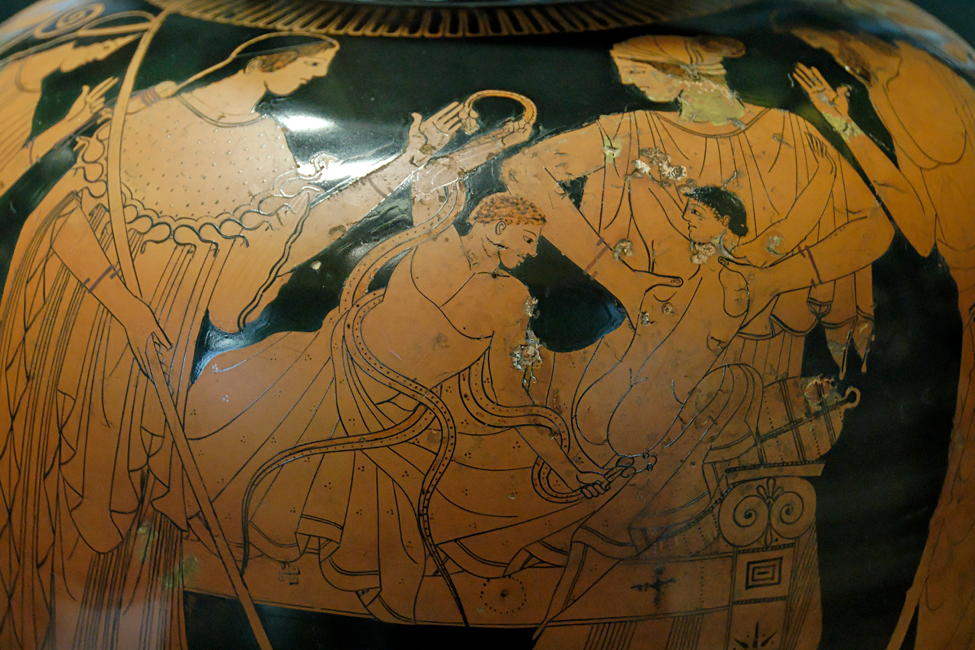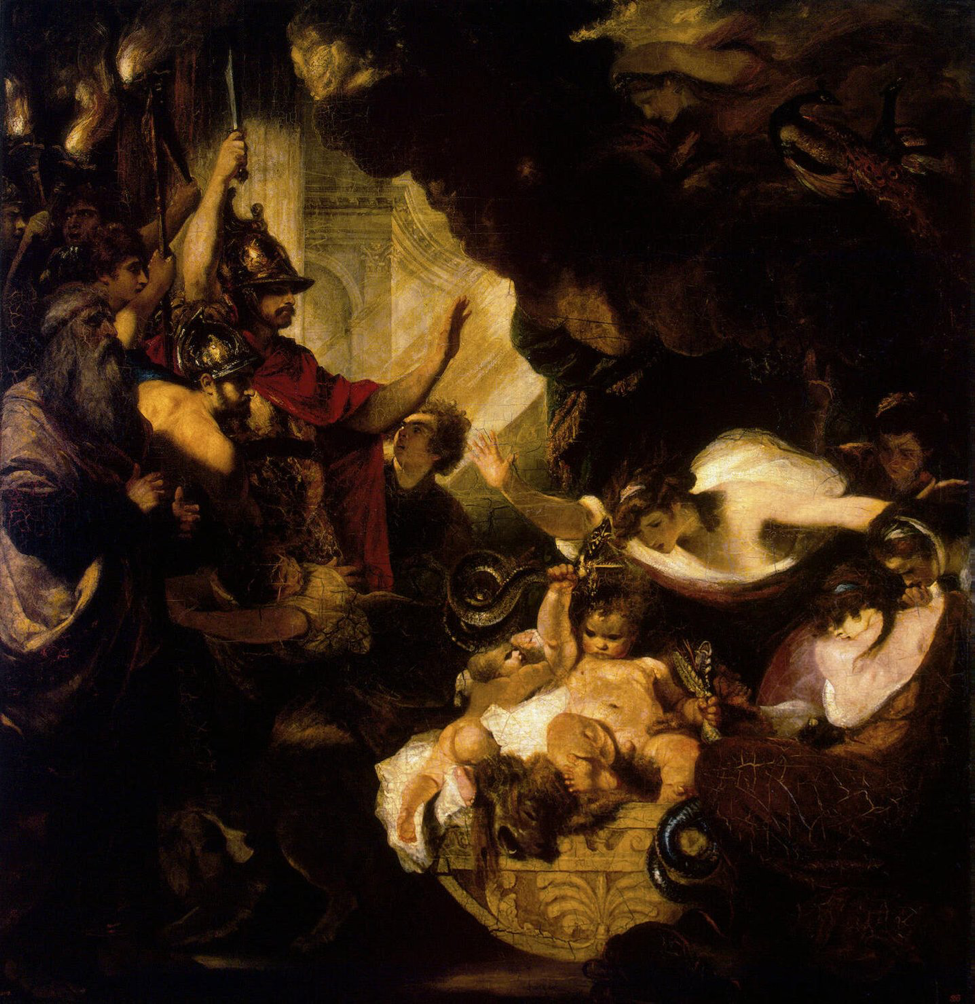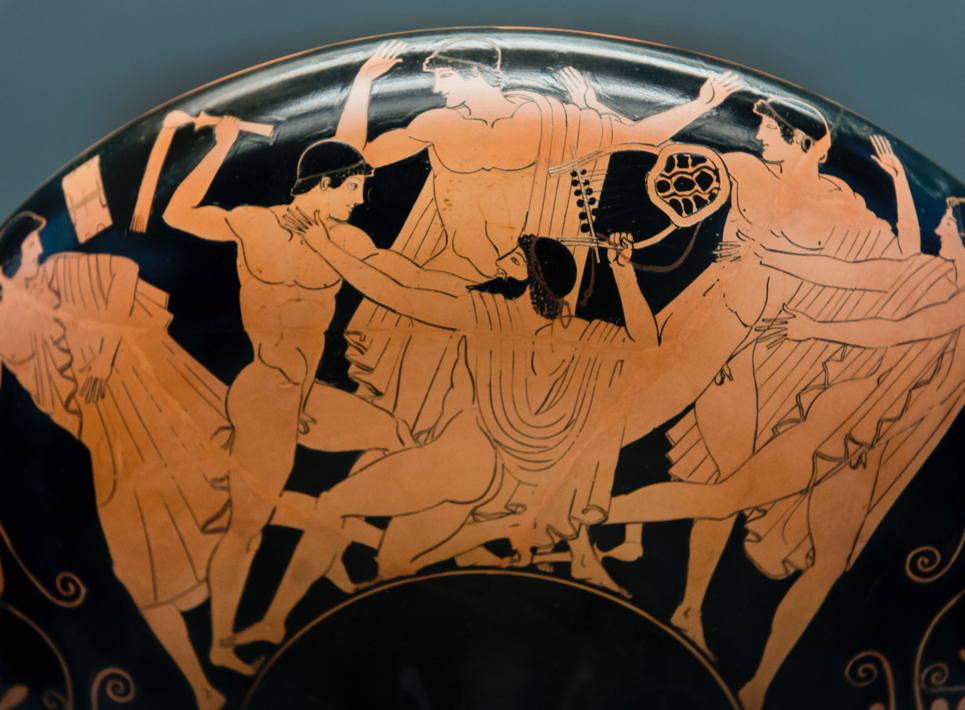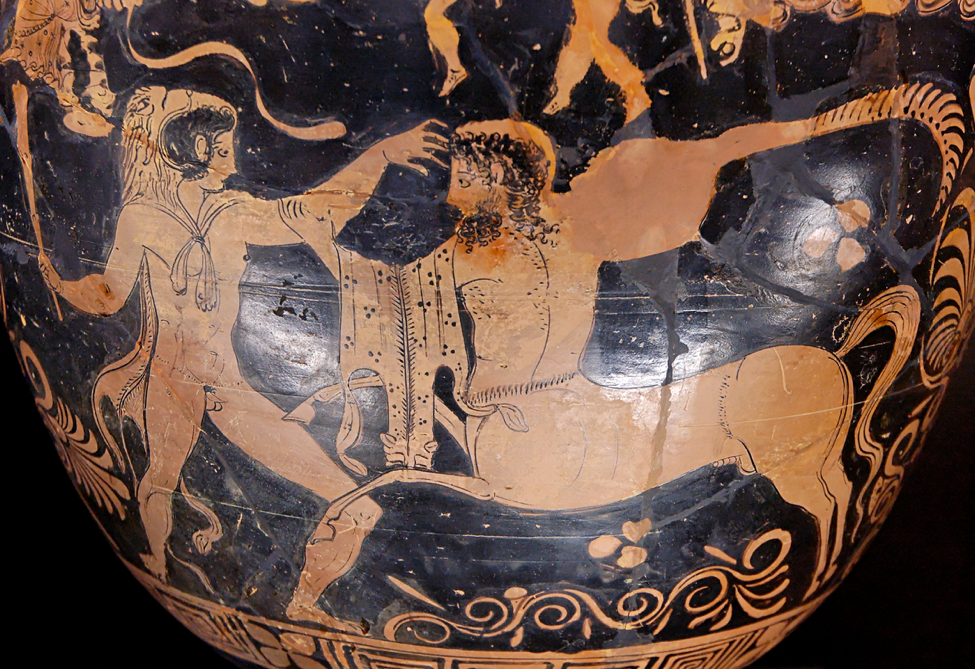1.16: Heracles
- Page ID
- 15353
\( \newcommand{\vecs}[1]{\overset { \scriptstyle \rightharpoonup} {\mathbf{#1}} } \)
\( \newcommand{\vecd}[1]{\overset{-\!-\!\rightharpoonup}{\vphantom{a}\smash {#1}}} \)
\( \newcommand{\dsum}{\displaystyle\sum\limits} \)
\( \newcommand{\dint}{\displaystyle\int\limits} \)
\( \newcommand{\dlim}{\displaystyle\lim\limits} \)
\( \newcommand{\id}{\mathrm{id}}\) \( \newcommand{\Span}{\mathrm{span}}\)
( \newcommand{\kernel}{\mathrm{null}\,}\) \( \newcommand{\range}{\mathrm{range}\,}\)
\( \newcommand{\RealPart}{\mathrm{Re}}\) \( \newcommand{\ImaginaryPart}{\mathrm{Im}}\)
\( \newcommand{\Argument}{\mathrm{Arg}}\) \( \newcommand{\norm}[1]{\| #1 \|}\)
\( \newcommand{\inner}[2]{\langle #1, #2 \rangle}\)
\( \newcommand{\Span}{\mathrm{span}}\)
\( \newcommand{\id}{\mathrm{id}}\)
\( \newcommand{\Span}{\mathrm{span}}\)
\( \newcommand{\kernel}{\mathrm{null}\,}\)
\( \newcommand{\range}{\mathrm{range}\,}\)
\( \newcommand{\RealPart}{\mathrm{Re}}\)
\( \newcommand{\ImaginaryPart}{\mathrm{Im}}\)
\( \newcommand{\Argument}{\mathrm{Arg}}\)
\( \newcommand{\norm}[1]{\| #1 \|}\)
\( \newcommand{\inner}[2]{\langle #1, #2 \rangle}\)
\( \newcommand{\Span}{\mathrm{span}}\) \( \newcommand{\AA}{\unicode[.8,0]{x212B}}\)
\( \newcommand{\vectorA}[1]{\vec{#1}} % arrow\)
\( \newcommand{\vectorAt}[1]{\vec{\text{#1}}} % arrow\)
\( \newcommand{\vectorB}[1]{\overset { \scriptstyle \rightharpoonup} {\mathbf{#1}} } \)
\( \newcommand{\vectorC}[1]{\textbf{#1}} \)
\( \newcommand{\vectorD}[1]{\overrightarrow{#1}} \)
\( \newcommand{\vectorDt}[1]{\overrightarrow{\text{#1}}} \)
\( \newcommand{\vectE}[1]{\overset{-\!-\!\rightharpoonup}{\vphantom{a}\smash{\mathbf {#1}}}} \)
\( \newcommand{\vecs}[1]{\overset { \scriptstyle \rightharpoonup} {\mathbf{#1}} } \)
\( \newcommand{\vecd}[1]{\overset{-\!-\!\rightharpoonup}{\vphantom{a}\smash {#1}}} \)
\(\newcommand{\avec}{\mathbf a}\) \(\newcommand{\bvec}{\mathbf b}\) \(\newcommand{\cvec}{\mathbf c}\) \(\newcommand{\dvec}{\mathbf d}\) \(\newcommand{\dtil}{\widetilde{\mathbf d}}\) \(\newcommand{\evec}{\mathbf e}\) \(\newcommand{\fvec}{\mathbf f}\) \(\newcommand{\nvec}{\mathbf n}\) \(\newcommand{\pvec}{\mathbf p}\) \(\newcommand{\qvec}{\mathbf q}\) \(\newcommand{\svec}{\mathbf s}\) \(\newcommand{\tvec}{\mathbf t}\) \(\newcommand{\uvec}{\mathbf u}\) \(\newcommand{\vvec}{\mathbf v}\) \(\newcommand{\wvec}{\mathbf w}\) \(\newcommand{\xvec}{\mathbf x}\) \(\newcommand{\yvec}{\mathbf y}\) \(\newcommand{\zvec}{\mathbf z}\) \(\newcommand{\rvec}{\mathbf r}\) \(\newcommand{\mvec}{\mathbf m}\) \(\newcommand{\zerovec}{\mathbf 0}\) \(\newcommand{\onevec}{\mathbf 1}\) \(\newcommand{\real}{\mathbb R}\) \(\newcommand{\twovec}[2]{\left[\begin{array}{r}#1 \\ #2 \end{array}\right]}\) \(\newcommand{\ctwovec}[2]{\left[\begin{array}{c}#1 \\ #2 \end{array}\right]}\) \(\newcommand{\threevec}[3]{\left[\begin{array}{r}#1 \\ #2 \\ #3 \end{array}\right]}\) \(\newcommand{\cthreevec}[3]{\left[\begin{array}{c}#1 \\ #2 \\ #3 \end{array}\right]}\) \(\newcommand{\fourvec}[4]{\left[\begin{array}{r}#1 \\ #2 \\ #3 \\ #4 \end{array}\right]}\) \(\newcommand{\cfourvec}[4]{\left[\begin{array}{c}#1 \\ #2 \\ #3 \\ #4 \end{array}\right]}\) \(\newcommand{\fivevec}[5]{\left[\begin{array}{r}#1 \\ #2 \\ #3 \\ #4 \\ #5 \\ \end{array}\right]}\) \(\newcommand{\cfivevec}[5]{\left[\begin{array}{c}#1 \\ #2 \\ #3 \\ #4 \\ #5 \\ \end{array}\right]}\) \(\newcommand{\mattwo}[4]{\left[\begin{array}{rr}#1 \amp #2 \\ #3 \amp #4 \\ \end{array}\right]}\) \(\newcommand{\laspan}[1]{\text{Span}\{#1\}}\) \(\newcommand{\bcal}{\cal B}\) \(\newcommand{\ccal}{\cal C}\) \(\newcommand{\scal}{\cal S}\) \(\newcommand{\wcal}{\cal W}\) \(\newcommand{\ecal}{\cal E}\) \(\newcommand{\coords}[2]{\left\{#1\right\}_{#2}}\) \(\newcommand{\gray}[1]{\color{gray}{#1}}\) \(\newcommand{\lgray}[1]{\color{lightgray}{#1}}\) \(\newcommand{\rank}{\operatorname{rank}}\) \(\newcommand{\row}{\text{Row}}\) \(\newcommand{\col}{\text{Col}}\) \(\renewcommand{\row}{\text{Row}}\) \(\newcommand{\nul}{\text{Nul}}\) \(\newcommand{\var}{\text{Var}}\) \(\newcommand{\corr}{\text{corr}}\) \(\newcommand{\len}[1]{\left|#1\right|}\) \(\newcommand{\bbar}{\overline{\bvec}}\) \(\newcommand{\bhat}{\widehat{\bvec}}\) \(\newcommand{\bperp}{\bvec^\perp}\) \(\newcommand{\xhat}{\widehat{\xvec}}\) \(\newcommand{\vhat}{\widehat{\vvec}}\) \(\newcommand{\uhat}{\widehat{\uvec}}\) \(\newcommand{\what}{\widehat{\wvec}}\) \(\newcommand{\Sighat}{\widehat{\Sigma}}\) \(\newcommand{\lt}{<}\) \(\newcommand{\gt}{>}\) \(\newcommand{\amp}{&}\) \(\definecolor{fillinmathshade}{gray}{0.9}\)Roman name: Hercules
Son of Zeus; mortal hero and eventually a god
The Birth of Heracles
Heracles was the son of Zeus and a mortal woman named Alcmene. Alcmene was married to Amphitryon, the heir to the throne of Tiryns. But Alcmene refused to consummate her marriage until Amphitryon had avenged the murder of her brothers, who had been killed by the Taphian Pirates. So before even sleeping with his wife, Amphitryon traveled to the Taphian Islands (off the western coast of Greece, near Ithaca) and he stayed there for several weeks, until he had killed all of the Taphian Pirates. On the night before Amphitryon returned from his journey, Zeus came to Alcmene in the form and shape of her husband. He told her that he had just come home from killing the pirates. Alcmene was overjoyed, and gladly allowed him into her bed. The next day when the real Amphitryon returned home, he wondered why she did not give him a hero’s welcome. After speaking with his wife, he discovered the truth: Alcmene had spent the previous night with someone else. Amphitryon did not believe Alcmene’s story, that the man she had been with had looked and sounded exactly like him, but the seer Teiresias told him that the interloper had been Zeus himself and that Alcmene’s story was true. Now Amphitryon believed her and they finally consummated their marriage.
When Hera discovered that Alcmene was pregnant with Zeus’ child, she was very unhappy, needless to say. When Alcmene went into labor, Hera sent Eileithyia to prevent the birth from taking place. Eileithyia sat outside the delivery room crossing her fingers and legs which halted the delivery. (No birth can take place unless Eileithyia is physically present and allows the birth to proceed.) Alcmene, who was pregnant with twin boys, was in a bad state and was close to breathing her last breath when her nurse, Galanthis, came up with a trick to break Eileithyia’s spell. She shouted that the baby had already come. Eileithyia, in confusion as to how this could have happened, jumped up and broke her spell, allowing Alcmene to deliver two baby boys. In her anger at being tricked, Eileithyia turned Galanthis into a weasel. The two babies were named Iphicles and Heracles. But the parents did not know which one of their sons was Zeus’ child and which one was the child of Amphitryon.

Heracles killing the snakes in his cradle on a stamnos in the Louvre
Heracles’ Early Adventures
Hera did not leave Heracles alone for long. When he was about eighteen months old, she sent two snakes to kill both Iphicles and Heracles while they were sleeping in their crib. While Iphicles screamed in terror and cowered in the corner, Heracles grabbed hold of the snakes and strangled one in each hand. Any doubt as to which was the son of Zeus and which the son of Amphitryon was solved by this event.

The Infant Heracules Strangling Serpents in his Cradle by Joshua Reynolds (1788), in the Hermitage Museum in St. Petersburg, Russia
As he grew, Heracles learned many important skills from great teachers, but he had a short temper and did not realize his own strength. When his music teacher, Linus (who was the brother of Orpheus), reprimanded him for not practicing enough, Heracles took his chair and smashed it over Linus’ head, killing him instantly. Amphitryon decided to send Heracles to live at his country estate to protect his family.

Heracles killing his music teacher, Linus, on a cup in the Antikensammlungen Museum in Munich
By the time Heracles was seventeen, he had grown to be a tall and strong youth. Around the same time, a lion was roaming in the area of Mount Cithaeron and was terrorizing the countryside. Thespius, the king of the area, asked Heracles to come and stay with him and help his men kill the lion. Thespius also happened to have fifty daughters. For fifty days Heracles went out to find the lion, and each night Thespius sent a different daughter in to sleep with Heracles, though Heracles thought it was the same daughter each night. After the fifty days, Heracles had killed the lion and all of Thespius’ fifty daughters were pregnant.
Hera Sends Madness
Heracles stayed in the area of Thebes [see Thebae on map] long enough to distinguish himself in a war the Thebans were fighting against a people called the Minyans. The king of Thebes was so happy to have had Heracles’ help that he offered his daughter, Megara, to Heracles as a wife. Megara and Heracles married and had two sons. They lived for a few years in peace, but Hera was still out to torment Heracles, so she sent madness to drive him mad. In his madness, Heracles killed his wife and children. When he regained his sanity, Heracles was devastated and decided to go to the Oracle at Delphi [map] to ask Apollo how he could be purified for this murder. The Pythia told him that he must go to Tiryns and perform twelve labors for the ruler, Eurystheus. If he could complete all twelve labors successfully, he would not only be purified of the murders, but he would achieve immortality. (The rule is that if a hero has one mortal parent, he or she is mortal. So Heracles was born a mortal, and this was his opportunity to achieve immortality.) Heracles did manage to successfully complete his twelve labors [see 12 Labors of Heracles].
The Death of Iphitus
After these twelve labors, Heracles set out, looking for a new wife with whom he could start over. Eurytus of Oechalia, who had taught Heracles how to shoot a bow and arrow, was looking for a husband for his daughter, Iole. Eurytus had set up the condition that whoever could beat him in an archery contest would win Iole, and Heracles won easily.
However, Eurytus knew about the misfortunes Heracles had had with Megara and refused to give Iole to Heracles. Heracles was furious, but at this point there was nothing he could do. At the same time this was happening, some of Eurytus’ mares went missing (sources vary on whether Heracles had anything to do with the disappearance). Eurytus’ son, Iphitus, who believed Heracles was innocent, went with Heracles to find the mares. The two eventually ended up in Tiryns at Heracles’ house. After they located the mares, the two friends were drinking on the roof of Heracles’ house. What happened after that is not clear, but somehow they got into an argument and Heracles ended up throwing Iphitus from the roof. Heracles was stricken with a disease as punishment for his crime. When he consulted the Delphic Oracle, the Pythia told Heracles that he had to sell himself as a slave for three years for whatever price Iphitus’ sons established.
Omphale
Heracles did as the Pythia said and he was sold to Omphale, the Queen and ruler of Lydia, who had inherited power from her late husband. The kingdom of Lydia had some enemies and now that Omphale had control of the kingdom, those enemies took the opportunity to cause problems. Heracles used his strength and fortitude to solve these problems for Omphale, who was incredibly grateful. She freed Heracles and the disease left him.
Deïaneira
After many years, and many adventures, Heracles found himself in Calydon, where he fell in love with King Oeneus’ daughter, Deïaneira. Heracles had a rival for her hand though in Acheloüs, a local river god. The two fought until Heracles managed to break off one of the god’s horns, which caused the god to yield. Heracles and Deïaneira married, but they were not able to live happily very long. Heracles, still not aware of his strength, killed Oeneus’ cupbearer when he gave the boy a quick blow as punishment for some offense. Oeneus forgave his son-in-law, but Heracles, in his guilt, insisted that he go into exile for his crime. Heracles left Calydon with Deïaneira in tow.
At some point in their trip, Heracles and Deïaneira came to a very deep and very large lake. Heracles could easily swim across the lake, but Deïaneira could not and Heracles could not carry her while swimming across. Just at that time, the centaur Nessus approached the newlyweds and he offered to ferry Deïaneira across the river. Heracles gratefully agreed to let Nessus swim across the river carrying Deïaneira on his back. Half way across the lake, however, Nessus began to rape Deïaneira. Heracles heard her screams and shot off one of his arrows dipped in the Hydra’s blood. Of course, the arrow hit its mark and, as Nessus knew, Hydra’s blood was a deadly poison. But Nessus decided to get back at Heracles, even though he would not live to see his revenge. As he lay dying, Nessus told Deïaneira that if she took some of his blood and wiped it on a robe for Heracles to wear, it would act as a love potion. Of course, this was a lie. Deïaneira was aware of her husband’s wandering affections, so she collected some of Nessus’ blood and kept it in case she ever had need of it. She had no idea that the deadly Hydra poison was also a part of her “love potion”.

Heracles fighting the centaur Nessus on a nestoris found in the Louvre
The Death and Apotheosis of Heracles
Deïaneira was justified in her suspicions of her husband, although it did not happen right away. But many years later, Heracles decided to get revenge on Eurytus, who had refused to give Heracles his daughter, Iole, in marriage. Heracles killed Eurytus and his sons in battle and brought Iole back home to be his concubine. Deïaneira knew about her husband’s many affairs, but she did not want to live in the same house with a younger rival, so she decided to put Nessus’ plan into action. She smeared Nessus’ blood on a beautiful new robe and gave it to her husband when he returned home, bringing Iole with him. Heracles put on the handsome robe to give a thanksgiving offering to Zeus for a successful return home, but as soon as he put on the robe, his skin immediately caught fire. When Heracles tried to take off the robe, parts of his skin came off with it, and Heracles (now with parts of his skin missing) continued to burn. Realizing the terrible mistake she had made, Deïaneira took her own life. But Heracles was in agony; he could not take off the robe (because it was sticking to his skin), but he could not put out the fire, and Heracles was burning so slowly that it seemed to be taking forever for him to die. Heracles decided to end his life as soon as possible.
He took his son Hyllus up into the mountains and asked him to build a funeral pyre Hyllus agreed to build the pyre, but he refused to light it because he could not bear to end his father’s life. A passing shepherd and his son, Philoctetes, agreed to light the pyre and so Heracles gave his famous bow and arrows to Philoctetes.
The fire burned away Heracles’ mortal flesh Heracles became immortal. He was taken up to Olympus to live with the other gods and he married his half-sister, Hebe. And Hera finally put aside her anger against him. It seems that Heracles could only find peace after his death.

